Mates from the Anarchist Yacht Clubb are preparing a publication called The current’s against us: as they are asking for writings and submissions, I was excited to contribute with an article on my favourite subject… You can either read it here or download a printable pdf version:
 Wanderers Of The World (673.5 KiB)
Wanderers Of The World (673.5 KiB)
To feel libertarian and think as an anarchist is not necessary to have read Bakunin, Kropotkin and Proudhon. In the same way, you don’t need to be an expert in sailing literature to repair a boat and become an offshore nomad. Yet, I was excited to discover that many of the subjects I care about (like life on board as an escape from our society, sailing with little or no money, D.I.Y. boat construction, etc.) are more or less explicitly dealt with in many of the classics by the most famous sailors.
Even Joshua Slocum, the very first man who sailed alone around the world, in 1895, was given his vessel as a wreck, and rebuilt it by himself. Despite having been a captain of commercial vessels for a long time, when he planned his trip he lacked the money for a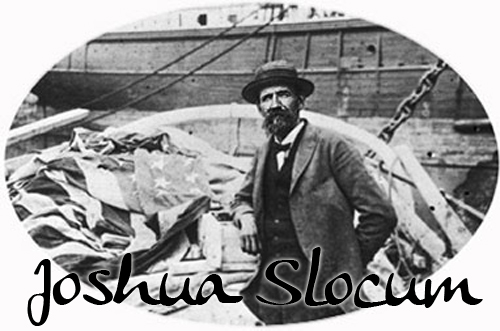 chronometer, and relied on traditional dead reckoning for longitude, using only a cheap tin clock for approximate time, and noon-sun sights for latitude. On many levels, he was a freak: in those days the seas were only crossed by commercial vessels, fishing boats and naval ships (1). Nobody understood a man sailing for pleasure, and to do it single handed was considered simply insane.
chronometer, and relied on traditional dead reckoning for longitude, using only a cheap tin clock for approximate time, and noon-sun sights for latitude. On many levels, he was a freak: in those days the seas were only crossed by commercial vessels, fishing boats and naval ships (1). Nobody understood a man sailing for pleasure, and to do it single handed was considered simply insane.
In his cult book “Sailing Alone around the World”, Capt Slocum write:
As I Sailed farther from the center of civilization I heard less and less of what would and what would not pay. Mrs. Stevenson (2), in speaking of my voyage, did not once ask me what I would make out of it. When I came to a Samoan village, the chief did not ask the price of gin, or say, “how much will you pay for roast pig?” but “Dollar, dollar,” said he; “white man know only dollar.”
“Never mind dollar. The tapo has prepared ava; let us drink and rejoice” […] “Our taro is good; let us eat. On the tree there is fruit. Let the day go by; why should we mourn over that? There are millions of days coming. The breadfruit is yellow in the sun, and from the cloth-tree is Taloa’s gown. Our house, which is good, cost but the labor of building it, and there is no lock on the door.”
While the days go thus in these Southern islands we at the North are struggling for the bare necessities of life. […] They have great reason to love their country and to fear the white man’s yoke, for once harnessed to the plow, their life would no longer be a poem. (3)
 Thirty years later the white man’s yoke was well established across the whole of Polynesia. Alain Gerbault, another single handed sailor, and the first Frenchman to circumnavigate the globe, became fascinated by ancient tribal society. He embraced the cause of aboriginals and used his popularity and his books to denounce “the fatal influence of white and Christian civilization over the primitive races” (4).
Thirty years later the white man’s yoke was well established across the whole of Polynesia. Alain Gerbault, another single handed sailor, and the first Frenchman to circumnavigate the globe, became fascinated by ancient tribal society. He embraced the cause of aboriginals and used his popularity and his books to denounce “the fatal influence of white and Christian civilization over the primitive races” (4).
Back to France in 1929, this wayward dandy ended his best-seller by saying:
If you visit, like I did, lot of countries, you will be left aghast by the incredible pretension of the white man who imposes everywhere his habits and his strange conception of existence. It has always been thus. Faced with the “conquistadores”, Inca civilization disappeared, despite being the best model of social organization ever achieved. Aztec civilization went the same way, though they were largely superior to the invaders in the science of astronomy and the art of sculpture. We must see that the Polynesians do not go the same way as the Caribbean civilizations, to the shame of a white race that did not want to understand how those aboriginals, happy and without needs, were also superior in the science of living well.
Our civilization did not want to learn the lesson given by those tribes. Despite its mechanical and scientific development, the false ideal, the conquest of money and the fictitious pleasures that it brings, oppresses individual happiness. That’s why it is showing signs of decline, and it will disappear as all other civilizations did.
Nevertheless, in recent years, we see a light of hope: many people start to understand that happiness lies in an approach to nature and in a suppression of needs, and that’s the only thing that may save our civilization from ruin. (5) …Zerzan would love that! And it’s dated 1928!
Alain Gerbault lived a short but adventurous life. Even his huge popularity did not survive the second world war. 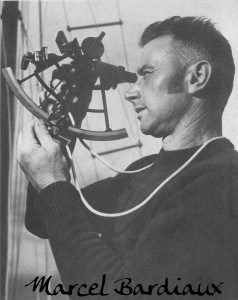 However, his greatest fan, Marcel Bardiaux, was so inspired that he dedicated his whole youth to saving money and training himself to eventually build a strong sloop and realize the first solo circumnavigation passing westward via Cape Horn. As his predecessors, he was conscious that “Real wealth is not to have a lot of money, but to know how to get by without…” (6)
However, his greatest fan, Marcel Bardiaux, was so inspired that he dedicated his whole youth to saving money and training himself to eventually build a strong sloop and realize the first solo circumnavigation passing westward via Cape Horn. As his predecessors, he was conscious that “Real wealth is not to have a lot of money, but to know how to get by without…” (6)
In spite of his mentor, Marcel Bardiaux had no affection for alcohol; on the contrary, as a non-smoker, vegetarian and relentless procurer of natural therapies, he went on sailing single handed until he was 88 years old (when he crossed the Atlantic for his 40th time), with an impressive trail of 400,000 nautical miles (more than 18 times the circumference of the Earth!).
His first writings were well received, and provided enough for him to build a stainless steel vessel designed to resist to any weather conditions, and require minimum maintenance (7). However, his later books never reached a wider public. They were D.I.Y. print runs that he would sell personally during his stopovers. Bardiaux was too radical and polemical to become a mass idol, and despite his incredible life and extensive writings, he eventually died alone.
 Led by an obstinate spirit of independence, this individualist with a sturdy character cultivated an acute sense of the freedom, and a bit of healthy misanthropy: “My need for freedom brought me to make a vessel, instead of mass-produce children […] Our planet is being overpopulated, while arable lands are more and more buried under concrete, it would be wise to put a brake on breeding, instead of encouraging it.”(8) Or “After eight years of independence [his first circumnavigation], I could no longer rejoin the herd, following blindly and without understanding the head sheep, bleating to the whistle, letting the dogs bite me, facing the prohibition of everything that is healthy and exalting.” (9)
Led by an obstinate spirit of independence, this individualist with a sturdy character cultivated an acute sense of the freedom, and a bit of healthy misanthropy: “My need for freedom brought me to make a vessel, instead of mass-produce children […] Our planet is being overpopulated, while arable lands are more and more buried under concrete, it would be wise to put a brake on breeding, instead of encouraging it.”(8) Or “After eight years of independence [his first circumnavigation], I could no longer rejoin the herd, following blindly and without understanding the head sheep, bleating to the whistle, letting the dogs bite me, facing the prohibition of everything that is healthy and exalting.” (9)
In 1955 Marcel Bardiaux made a stopover in Port Louis (Mauritius), and he was visited by the young Bernard Moitessier, who showed him his brand new Marie Thérèse II, the D.I.Y yawl he made after sinking his first junk on Diego García atoll 3 years before. Bardiaux thought the boat was “all the opposite of my conception of an ideal vessel” (10) and told Moitessier about his project of building one entirely from stainless steel (7). Three years later, sailing from Saint Elena to Ascension on Marie Thérèse II, Moitessier realized that her mast and hull were already rotten, and regretted his “hasty job”:
This free life about which I had dreamed will never be a free life. Not with this boat in any case, not when we have to spend time, in every port, on “major repairs”, to maintain alive a hull which inexorably, little by little, goes where the dead crabs go…
 […]I already think of my next boat… I think about the idea which Bardiaux suggested to me, in Mauritius, of a stainless steel boat. […]a floating house which would last the rest of my existence, requiring little maintenance, almost none, allowing me to dedicate myself more to what would please me, without having to prostitute myself as soon as a bearing is reached. (11)
[…]I already think of my next boat… I think about the idea which Bardiaux suggested to me, in Mauritius, of a stainless steel boat. […]a floating house which would last the rest of my existence, requiring little maintenance, almost none, allowing me to dedicate myself more to what would please me, without having to prostitute myself as soon as a bearing is reached. (11)
Moitessier uses the radical expression “prostitute myself ” to say “getting employed”. He actually knew what he was talking about, because he had just spent two years in South Africa “working as forced labour” to finance his voyage. But he never did the same job twice, “because one of the features of my character is to always avoid the specialization, preferring sufficient mastery in as many activities as possible.” (12) In addition to being a talented writer, this bohemian sailor was a free diver and a swimming champion, he has experimented with permaculture in the atolls, boat construction by any means (including wood+papier-mache!), and worked at everything from plantation manager to carpenter, mechanic, door-to-door salesman, sailing teacher, etc.
 In the fifties, together with his best friend Henry Wakelam (another single handed sailor and brilliant makeshift expert) he was among the first cruising sailors to use rope made of synthetic fibers: they scavenged serviceable yarns from nylon hawsers discarded by whaling ships and twisted them into three-strand line to use as halyards! The two friends learned much about scrounging and living off the land, including cormorants and penguins killed by slingshot in the harbor… Everything was allowed, as long as it helped “to realize this dream that so many people feed lovingly deep in their hearts: to set sail for unknown horizons, leaving behind the constraints of life among society.” (13) Because “offshore, yes, it is the freedom, a complete freedom, immense as the ocean which Marie Thérèse II navigates, so beautiful and peaceful as this starry world which I contemplate at night.” (14)
In the fifties, together with his best friend Henry Wakelam (another single handed sailor and brilliant makeshift expert) he was among the first cruising sailors to use rope made of synthetic fibers: they scavenged serviceable yarns from nylon hawsers discarded by whaling ships and twisted them into three-strand line to use as halyards! The two friends learned much about scrounging and living off the land, including cormorants and penguins killed by slingshot in the harbor… Everything was allowed, as long as it helped “to realize this dream that so many people feed lovingly deep in their hearts: to set sail for unknown horizons, leaving behind the constraints of life among society.” (13) Because “offshore, yes, it is the freedom, a complete freedom, immense as the ocean which Marie Thérèse II navigates, so beautiful and peaceful as this starry world which I contemplate at night.” (14)
In 1969, Bernard Moitessier become a worldwide legend: being the first man to circumnavigate the globe single handed and non-stop, instead to go back to UK (where he would possibly get the first golden globe prize) he decided to head once again toward Cape of Good Hope and Cape Lewin, and he went on sailing until Tahiti, almost two-thirds of the way round a second time. The press reported the message he threw onto a cargo ship with his slingshot: “I continue without stopover towards the islands of the Pacific, because I am happy at sea, and maybe also to save my soul”
Moitessier’s life and literary works marked an important waypoint in the constitution of a “sea vagabond” identity: “I am a citizen of the most beautiful nation on earth. A nation whose laws are harsh yet simple, a nation that never cheats, which is immense and without borders, where life is lived in the present. In this limitless nation, this nation of wind, light, and peace, there is no other ruler besides the sea.”
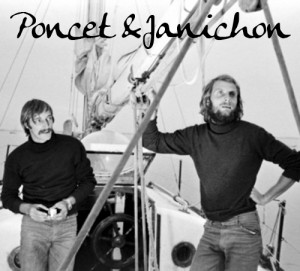 Many people were fascinated by this philosophy… Among them, Gérard Janichon and Jérôme Poncet, who were barely 19 years old in 1968, when they went and meet Moitessier to tell him about their project of an adventurous circumnavigation passing both the arctic and antarctic circles… One year later, the two friends set sail for a five-year voyage on their 33ft cutter. To realize their dream, they sailed 55,000 nm, most of them over high latitudes. “To leave, to want to leave everything just out of adolescence, it was to deliberately give direction (and also deep meaning) to our lives, accepting being put aside, pariahs for some, object of jealousy for others. We had to be sure that we would always prefer the unbeaten paths to the paved road. […] In our spirit, the circumnavigation was not an escape, but a solution, an answer. We arose from the middle class and to break the chains of the bourgeois yoke was not as easy as one might imagine. We wanted to become gypsies. Gypsies of the ocean. A gypsy is born gypsy. He doesn’t need to explain his freedom, his conception of happiness; but we had to justify ours:
Many people were fascinated by this philosophy… Among them, Gérard Janichon and Jérôme Poncet, who were barely 19 years old in 1968, when they went and meet Moitessier to tell him about their project of an adventurous circumnavigation passing both the arctic and antarctic circles… One year later, the two friends set sail for a five-year voyage on their 33ft cutter. To realize their dream, they sailed 55,000 nm, most of them over high latitudes. “To leave, to want to leave everything just out of adolescence, it was to deliberately give direction (and also deep meaning) to our lives, accepting being put aside, pariahs for some, object of jealousy for others. We had to be sure that we would always prefer the unbeaten paths to the paved road. […] In our spirit, the circumnavigation was not an escape, but a solution, an answer. We arose from the middle class and to break the chains of the bourgeois yoke was not as easy as one might imagine. We wanted to become gypsies. Gypsies of the ocean. A gypsy is born gypsy. He doesn’t need to explain his freedom, his conception of happiness; but we had to justify ours:
“We are young but a faith lives in us. That only the journey and the sea may fulfill us. It seems to us vain and too easy to claim oneself a man by screwing a plaque to the door of an apartment acquired by a twenty-year credit”
Gérard and Jérôme built a boat and headed to the arctic, not as a sporting exploit, but “To build a life such as we would like to have lived.” Because “freedom, maybe, or what approaches it most, is situated on the side of the horizon when we always push it a little farther. But freedom, as the rest, have to be learned; there is initiation. Rediscovery of truths values, essences. Man comes from the sea, it is logical that he return to it, today more than ever, even if it is just to refuse the reign of the artifice and the false values which eventually forge him a mask.” (15)
In 1974, Gérard Janichon published a volume about their voyage, selling more than 150,000 copies. He went on sailing and lead an adventurous life, while becoming a confirmed writer and novelist.
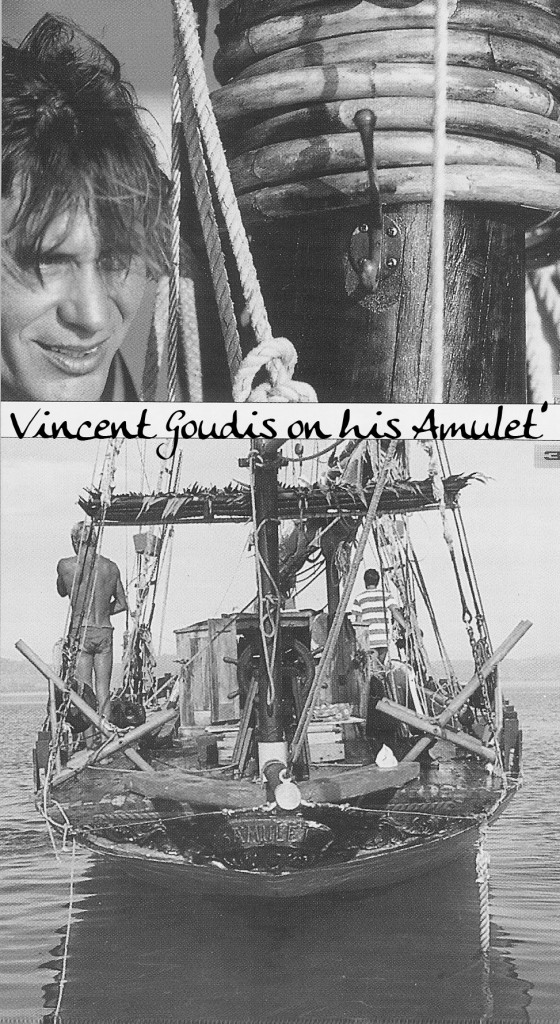 Last but not least, I have to mention the books of another authentic nomad of the
Last but not least, I have to mention the books of another authentic nomad of the
seas: Vincent Bonnet, aka Goudis, also very popular in the sailing community. Inspired by adventurers like Henry de Monfreid and Jack London, Goudis started his peregrination around the world in 1976, when he was 20 years old, with 40 bucks in his pocket and a few bottles of wine in the ship’s store. He didn’t sail back to France until 2001, after 25 years of adventures! His autobiographic writings are a thrilling sequence of sailing, fishing, free diving, escape from customs and cops, love stories, wrecks, malaysian pirates, salvage, and so on… But the pentagram of his symphony is always the same: no money, no valid papers, and a lot of manual bilge pumping. “The less we have the means, the more the journey is fruitful, interesting. […] We suffer more and more the cerebral atrophy caused by the profusion of the “navigational aids” […] Half of sailors ignore the discipline of maneuvering without engine, or without a radio.” (16)
Sometimes “A small voice says to me that to always have dirty nails, empty pockets and a rotting boat after so many years is a heavy price to pay for my passion for the big horizons” (17) But “I do not regret and I shall never regret my flirtation with salt water. The Sea showed its delicious bottoms to me, kid, on the African coasts; it let me caress for a long time its ever-transforming body. It hit me sometimes in its wrath as a wild mistress. But the Sea is the fundamental inspiration of my life. The one who allowed me to escape the bothers suffered today by the land lubbers.”(18)
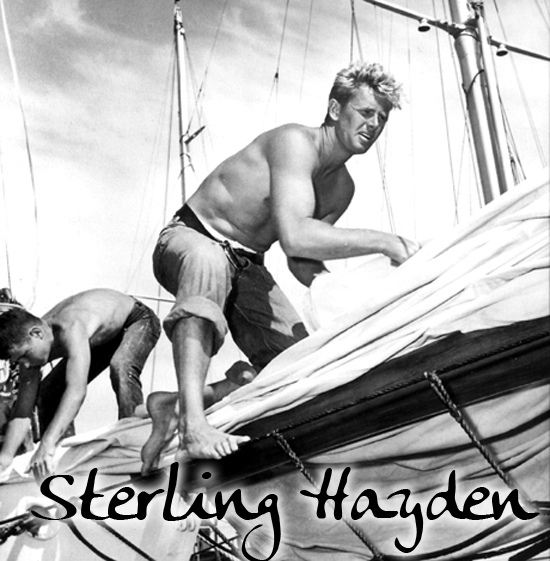 In his most famous book, Bleu Sauvage, Goudis quotes Sterling Hayden (who was, before than an actor, a real adventurer and a great sailor): “To be truly challenging, a voyage, like a life, must rest on a firm foundation of financial unrest. Otherwise, you are doomed to a routine traverse, the kind known to yachtsmen who play with their boats at sea… cruising, it is called. Voyaging belongs to seamen, and to the wanderers of the world who cannot, or will not, fit in.” (19)
In his most famous book, Bleu Sauvage, Goudis quotes Sterling Hayden (who was, before than an actor, a real adventurer and a great sailor): “To be truly challenging, a voyage, like a life, must rest on a firm foundation of financial unrest. Otherwise, you are doomed to a routine traverse, the kind known to yachtsmen who play with their boats at sea… cruising, it is called. Voyaging belongs to seamen, and to the wanderers of the world who cannot, or will not, fit in.” (19)
Here we are, once again, among salty vagabonds… In the context of the social and ecological movements of the late sixties, Bernard Moitessier’s claim for a better world and for a lifestyle closer to nature went even further, ’till day-dreaming -in his typical naive way- about a community of ocean hippies (or, in our terms, a collective of post-capitalist pirates) anchored by an utopian island:
“One day, we shall have tiny walkie-talkies with batteries, no bigger than a package of cigarettes, that cover thousands of miles, so that friends can communicate between without passing by the ears of the others… Hey mate, we are eight boats anchoring in a really peaceful tiny place, five couples have a child each, three others decided not to have children, but it is as if they had each five kids. And our five only children, they have four brothers and sisters. Come to join us… -And what do you do in this peaceful tiny place? – we do nothing, we live, simply, we planted things in the ground and they grow, potatoes, carrots, salad, we scattered everywhere the seeds of our plants, the small leaves in five fingers shape already grow! And we have books of the world written by real scholars. Come, we don’t need to pronounce the word “cash” any more since we are there together, we are good, in the warmth, let’s leave the others, never mind about them, the others will join us one day, those who want, you will see, come!” (20)
Off course, since the sixties, many more people decided to live on sail boats, seeking freedom at sea, and this culture is still alive, at least in France, where in any harbor you can find some freaky sailor (with his old-school vessel, and the typical plexiglass dome on the roof…). Furthermore, lately, more and more mates from the €uropean squatter movement started to head out to sea, sick off so much repression and looking for an healthier life-style… One month ago, they even squatted an abandoned shipyard in Bretagne, near Brest (21)… Are we going to see the proliferation of some sort of punk-sailor T.A.Z? Will the the nautical nomadism ideal grew and develop a proper identity like the traveller’s movement did ashore in the ’80? There will be squatted peers, meetings and festivals all over the seas? Blending the latest technologies with ancient knowhow, could we sew the seeds of a nautical utopia? Maybe a nomad community with several settlements on remote islands? A floating network of wandering sailors, heirs to the bucaneer’s tradition, who share resources and ideals?
In the last century, Gerbault, Bardiaux, Moitessier, Janichon and Goudis have been among the greatest examples of freedom at sea and critic thinking.
Now let’s be inspired…
Translated from my Spanglish by Katja x
Notes:
1) Yachting already existed, the firsts yacht clubs dating back to the XVIII century, but it was an activity reserved to the highest aristocracy… and of course the yachts where handled by a full crew!
2) Robert Louis Stevenson’s widow, who Slocum met in Upolu, Samoa.
3) From “Sailing Alone around the World” -Capt Joshua Slocum- Penguin Classics, page 138.
4) From“L’Evangile du Soleil” – Alain Gerbault- Fasquelle Editeurs 1932, page 198. (Own translation)
5) From“L’Evangile du Soleil” – Alain Gerbault- Fasquelle Editeurs 1932, page 214. (Own translation)
6) From “L’École de la Vie (1910/1994)” – Marcel Bardiaux– page 103. (Own translation)
7) This ketch, called Inox, would deserve a whole article all to herself: she was built with no compromise, following the idealistic dream of an ever-lasting and unsinkable s.v. Costing 6 years of insane work, she is the most ambitious D.I.Y. boat project I never heard about, along with the Nahoon refit by Henry Wakelam. 50 years and 360.000 miles later, she is still in use…
8 ) From “L’École de la Vie (1910/1994)” – Marcel Bardiaux– page 176. (Own translation)
9) From “Entre deux tours du monde” – Marcel Bardiaux, 1979– page 16. (Own translation)
10) From “Au 4 Vents de l’Aventure, Par le Chemin des Écoliers” – Marcel Bardiaux, Flammarion, 1958; Arthaud 1998– page 251. (Own translation)
11) From “Vagabond des Mers du Sud” -Bernard Moitessier -Flammarion, 1960; Arthaud 1988. Page 200/201. (Own translation)
12) From “Vagabond des Mers du Sud” -Bernard Moitessier -Flammarion, 1960; Arthaud 1988. Page 118. (Own translation)
13) From “Vagabond des Mers du Sud” -Bernard Moitessier -Flammarion, 1960; Arthaud 1988. Page 218. (Own translation)
14) From “Vagabond des Mers du Sud” -Bernard Moitessier -Flammarion, 1960; Arthaud 1988. Page 164. (Own translation)
15) From “Damien autour du monde” – Gérard Janichon- Arthaud,1973; Transboreal 2010. Page 17/18. (Own translation)
16) From “Bleu Sauvage” – Vincent Goudis – Albin Michel 1991. Page 121. (Own translation)
17) From “Cap’tain Vagabond” – Vincent Goudis – Albin Michel 1997. Page 94. (Own translation)
18) From “Heureux qui, comme Goudis…” – Vincent Goudis – Page 12. (Own translation)
19) From “Bleu Sauvage” – Vincent Goudis – Albin Michel 1991. Page 122.
20) From “La longue route” -Bernard Moitessier- Arthaud 1986. Page 210. (Own translation)
21) The squat is called Moulin Mer


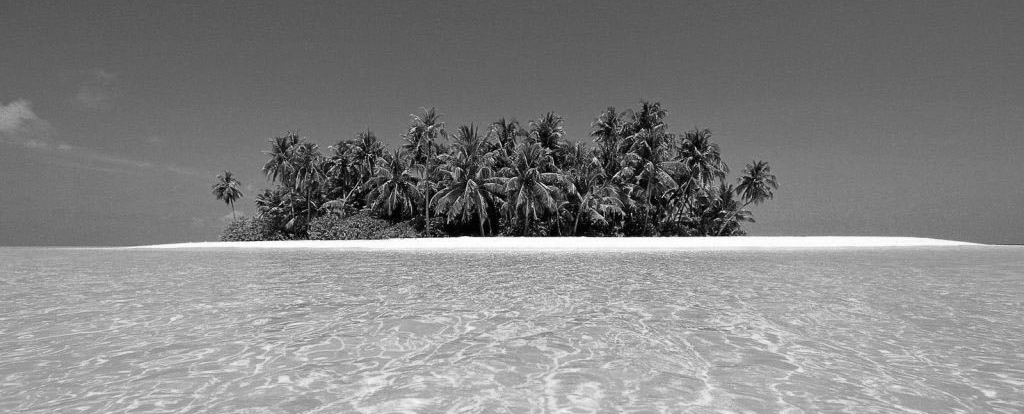
6 comments
5 pings
Skip to comment form ↓
Joshua Saunders
February 3, 2014 at 2:44 pm (UTC 0) Link to this comment
Dear L’Alliance,
I am a broadcaster from the Falklands and hoped to use your picture of Jerome and Janichon for a brief piece about the life of Jerome. If you could let me know whether this is ok I would be greatly obliged. Many thanks,
Josh Saunders
Falkland Islands Television
metello
February 3, 2014 at 6:37 pm (UTC 0) Link to this comment
Hi Josh,
Thanks for ask… As you can see, this is a no commercial web page, and we often pick up pictures and contents from books or other web sites: we don’t mind too much about copyright issues. I really can’t remember where I found that old picture of Jérôme and Gérard, but I guess that nobody will be annoyed if you use it!
All the best
Metello (s.v.L’Alliance)
Joshua Saunders
February 3, 2014 at 7:18 pm (UTC 0) Link to this comment
Cheers Metello, that’s great news. I really liked the sight, it provided a great insight to Jérôme’s life prior to interviewing him also. Thanks for the good work.
Rainer
July 6, 2017 at 7:15 pm (UTC 0) Link to this comment
A swell piece. Surprised though you didn’t also write about George Dibbern.
http://www.georgedibbern.com/quest-dibbern.html
metello
July 9, 2017 at 5:31 pm (UTC 0) Link to this comment
Thanks for the link!! I didn’t know about George Dibbern and his book “The Quest”: it looks extremely interesting to me! I will purchase the new reprinted edition right now…
Vasilij Trubicyn
May 16, 2019 at 4:49 pm (UTC 0) Link to this comment
Joshua Slocum used Lunar Distance method to find his longitude.
Vagabondi del Mare | L'Alliance
March 16, 2013 at 9:05 am (UTC 0) Link to this comment
[…] post is also available in english) Questo post è la traduzione di un articolo che ho scritto nel dicembre 2012 per la fanzine […]
Vagabondi del Mare | L'Alliance
March 17, 2013 at 3:21 pm (UTC 0) Link to this comment
[…] post is also available in english) Questo post è la traduzione di un articolo che avevo scritto per la fanzine anarco-velista The […]
Vagabondi del mare | L'Alliance
March 17, 2013 at 9:26 pm (UTC 0) Link to this comment
[…] post is also available in english) Questo post è la traduzione di un articolo che avevo scritto per la fanzine anarco-velista The […]
Vagabundos del mar | L'Alliance
February 16, 2015 at 8:09 pm (UTC 0) Link to this comment
[…] post es la traducción de un artículo que escribí en inglés, en 2012, para la fanzine “anarco-velista” The current’s against us. También hay una […]
Wonderers of the World | Jorge Rocks
June 23, 2017 at 7:42 pm (UTC 0) Link to this comment
[…] reading the full story on L’Alliance […]